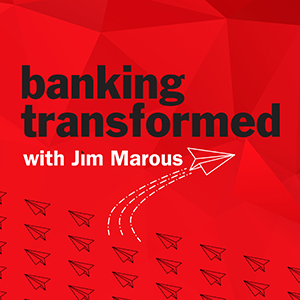In the real estate market, they call it “curb appeal” — what the prospective buyer sees from the sidewalk. As any homebuyer knows, a pretty facade can mask antiquated plumbing and electrical systems, old appliances and worse.
Ravi Vakacherla, EVP and Chief Transformation Officer at People’s United Bank, uses a similar analogy for what many financial institutions have done to “go digital.” He calls it “painting the front of the house.”
As he tells Jim Marous, Co-Publisher of The Financial Brand and CEO of the Digital Banking Report, during a podcast interview, “People say, ‘We have digital account opening’,” Vakacherla states, “but they really don’t. What they actually have is ‘digital application collection’.”
The banker maintains that to be true “digital account opening” the process must be “straight through” — digital all the way — so the customer can transact with it immediately. Instead, what too often happens due to partially manual processes, is that it’s several days before the account is actually open, and then the institution sends the customer an email to let them know.
Chief Transformation Officer is an unusual title in banking. Vakacherla was given the title in August 2020. His background at People’s United made him a good choice. During his two decades with the Connecticut-based regional, which has total assets of $63 billion, he’s been a programmer and a systems architect on the IT side but on the business side has managed Payments and Digital Channels and headed up Digital Product Management and Banking Operations.
As he says, with a laugh, “My IT friends would say I left the light and went to the dark side. But my business friends would say I left the dark side and came to the light side.”
The biggest revelation in making the switch from IT to Businessbusiness, he says, was how little he understood of the details of the business side of the bank, it and how that understanding is so important.

Industry Cloud for Banking from PwC
PwC’s Industry Cloud for Banking applies our deep industry knowledge to your specific business needs

Move the Needle from Attrition to Acquisition
Vericast’s 2024 Financial TrendWatch explores seven of today’s most critical financial services trends to provide a complete view of the current loyalty landscape.
Read More about Move the Needle from Attrition to Acquisition
No Ivory Tower Papers that People Ignore
Based in Bridgeport, Conn., People’s United operates in the shadow of JPMorgan Chase. The megabank, Vakacherla observes, has about 50,000 technology staffers, almost eight times as many as People’s total headcount of 6,500. So how does the smaller bank compete?

Ravi Vakacherla, EVP & Chief Transformation Officer at People’s United Bank
The contest is not as lopsided as those figures may suggest. The rapid evolution of digital technology has improved the odds for financial institutions of People’s Bank’s size or smaller, Vakacherla maintains, if they take advantage of the new capabilities. Doing that requires the right approach and structure.
As People’s Bank set up a chief transformation office and the CTO position, they saw on the one hand it could focus on emerging technology research, which Vakacherla dubs “Ivory Tower Publication Group,” producing papers that people ignore. On the other hand, as CTO he could have simply stayed in his previous role with transformation added to his mandate. “Too many distractions,” was the conclusion there.
However, he does retain some product responsibility, including for digital banking, cards, treasury management and government banking. In addition, other teams that report to Vakacherla work on process improvement and transformation opportunities including robotic process automation (RPA) and low-code/no-code deployment.
Ravi Vakacherla on Using Fintechs:
Fintechs are not encumbered by legacy technology and are focused on solving problems in a niche area. Why not take advantage of that? Combine their innovation with your distribution.
Read More: Digital Transformation Is About New Business Models, Not New Tech
Focus on Both Customer and Employee Experience
The way for banks and credit unions to create a truly engaging digital experience is to “think like a customer, not like a banker,” says Vakacherla. For People’s Bank, this included having employees walk through malls (pre Covid) asking consumers about changes to mobile banking app features. Vakacherla’s group also spoke with the bank’s call center and branch staff to ask what customers are most frustrated about, “so we didn’t just have the back office technology team spinning up something based on papers that they have read.”
“We want to fit our products and services into the customer’s life journey and not ask them to take a detour from what they’re trying to do.”
— Ravi Vakacherla, People’s United Bank
Ultimately the bank identified 182 customer pain points. They’re currently working their way through resolving them.
“What we are trying to do,” he continues, “is show value and enhance the customer’s journey, as opposed to, ‘Here’s a bunch of stuff that we have. Why don’t you take a detour from whatever you’re doing and buy these products and services?”
Equally important, in Vakacherla’s mind, is to focus on the employee experience.
“We realized early on that you must also focus on employee experience,” he states. Otherwise you can talk all about customer experience and buy the next fancy tool, but if your customer-facing employees don’t understand the product, they won’t be able to support it.
In the end, it is the employees that are the conduit between the technical product/service and the customer, says Vakacherla. If they do understand, they will become digital advocates for the institution. People’s United has taken steps to better train and engage its employees. including using product simulators.
Read More:
- 7 Essentials of Digital Banking Transformation Success
- How to Build a Data Culture that Supports Digital Banking Transformation
Challenges to Digital Transformation
While the importance of digital transformation is frequently cited, less often discussed are the difficulties and realities that restrict progress at traditional institutions. Vakacherla addressed several of these during his podcast interview.
The speed at which consumers expect change. Consumers don’t neatly compartmentalize their lives. What they experience in dealing with a streaming media service impacts what they come expect for any digital service. The baseline keeps getting raised and financial institutions can’t ignore this.
Banking’s many “checkpoints,” including regulatory and other risk factors. Innovation for traditional banks and credit unions is not as simple as saying, ‘If this is the right thing for the customer, let’s just do it’,” the executive notes.
Impact of change on current customers. If an institution wants to deploy a new mobile banking app, and it already has 700,000 customers using its current app, switching and changing becomes a lot more difficult. “You’re potentially impacting existing customers who are using the service and are expecting it to perform a certain way,” Vakacherla observes.
Rapidly increasing complexity. Several years ago a mobile banking service might have had three points of integration within a financial institution — front-end, core system, bill pay, Vakacherla explains. Now, he says, there are at least 16 integration points relating to the addition of card controls, geo-fencing, online account opening verifications and many other features.
These challenges are one key reason to create the kind of digital transformation structure that People’s Bank has set up.

Agile Development: Work in Progress
Due in part to the challenges listed above, People’s United is still in the beginning stages of moving from a traditional waterfall (sequential) approach to digital banking development to an agile (incremental and iterative) approach, according to Vakacherla.
“‘Agile’ is an overused word,” he concedes, ” but it’s not a fad.” He’s a firm believer in many of the agile techniques used by fintechs — “focused teams and daily stand-ups” among them.
Closely related, in Vakacherla’s view, is the need to add staff members who know and understand the details of a particular product to make decisions about that product.
“It’s amazing how in some institutions you have people making the decisions who are far removed from the actual product,” the banker states. At People’s United, he says, “We created a product owner model, where the product owners are empowered to make a decision.”
7 Essential Takeaways from the People’s Bank Digital Experience
Here is a distillation of Ravi Vakacherla’s main points regarding digital transformation.
- Do not underestimate the importance of culture, leadership and discipline. That is more than any budget or product that you buy or build.
- Don’t fall into the fallacy of a sexy transformation initiative announced with bells and whistles. Transformation is 1% incremental changes executed with discipline.
- Digital transformation is not about the goals. It is about the systems that help you get to the goal. Change your systems, not your goals.
- Employee experience is as important as customer experience. Help your employees be more productive and they will pay it back in spades.
- Stop thinking like a banker and listen to your customers. Don’t presuppose that you understand them.
- Understand that you have to be agile and willing to pivot. Don’t be afraid of mistakes.
- Democratize technology and data. They should not be the privy domain of a small group that says, ‘We will come and automate everything for you.’ Put technology in the hands of the people who are facing the customers and supporting the various lines of business.








